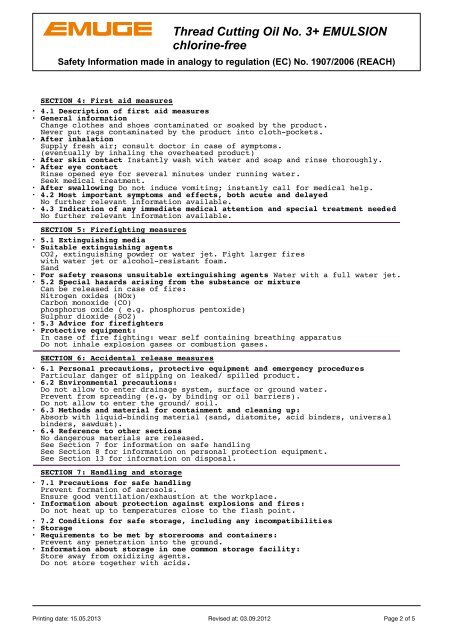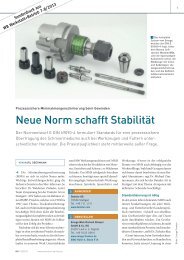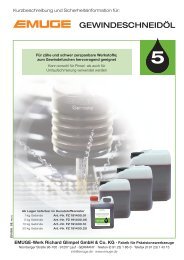THREAD CUTTING OIL CHLORINE-FREE - Emuge-Franken
THREAD CUTTING OIL CHLORINE-FREE - Emuge-Franken
THREAD CUTTING OIL CHLORINE-FREE - Emuge-Franken
Create successful ePaper yourself
Turn your PDF publications into a flip-book with our unique Google optimized e-Paper software.
Thread Cutting Oil No. 3+ EMULSION<br />
chlorine-free<br />
Safety Information made in analogy to regulation (EC) No. 1907/2006 (REACH)<br />
SECTION 4: First aid measures<br />
· 4.1 Description of first aid measures<br />
· General information<br />
Change clothes and shoes contaminated or soaked by the product.<br />
Never put rags contaminated by the product into cloth-pockets.<br />
· After inhalation<br />
Supply fresh air; consult doctor in case of symptoms.<br />
(eventually by inhaling the overheated product)<br />
· After skin contact Instantly wash with water and soap and rinse thoroughly.<br />
· After eye contact<br />
Rinse opened eye for several minutes under running water.<br />
Seek medical treatment.<br />
· After swallowing Do not induce vomiting; instantly call for medical help.<br />
· 4.2 Most important symptoms and effects, both acute and delayed<br />
No further relevant information available.<br />
· 4.3 Indication of any immediate medical attention and special treatment needed<br />
No further relevant information available.<br />
SECTION 5: Firefighting measures<br />
· 5.1 Extinguishing media<br />
· Suitable extinguishing agents<br />
CO2, extinguishing powder or water jet. Fight larger fires<br />
with water jet or alcohol-resistant foam.<br />
Sand<br />
· For safety reasons unsuitable extinguishing agents Water with a full water jet.<br />
· 5.2 Special hazards arising from the substance or mixture<br />
Can be released in case of fire:<br />
Nitrogen oxides (NOx)<br />
Carbon monoxide (CO)<br />
phosphorus oxide ( e.g. phosphorus pentoxide)<br />
Sulphur dioxide (SO2)<br />
· 5.3 Advice for firefighters<br />
· Protective equipment:<br />
In case of fire fighting: wear self containing breathing apparatus<br />
Do not inhale explosion gases or combustion gases.<br />
SECTION 6: Accidental release measures<br />
· 6.1 Personal precautions, protective equipment and emergency procedures<br />
Particular danger of slipping on leaked/ spilled product.<br />
· 6.2 Environmental precautions:<br />
Do not allow to enter drainage system, surface or ground water.<br />
Prevent from spreading (e.g. by binding or oil barriers).<br />
Do not allow to enter the ground/ soil.<br />
· 6.3 Methods and material for containment and cleaning up:<br />
Absorb with liquid-binding material (sand, diatomite, acid binders, universal<br />
binders, sawdust).<br />
· 6.4 Reference to other sections<br />
No dangerous materials are released.<br />
See Section 7 for information on safe handling<br />
See Section 8 for information on personal protection equipment.<br />
See Section 13 for information on disposal.<br />
SECTION 7: Handling and storage<br />
· 7.1 Precautions for safe handling<br />
Prevent formation of aerosols.<br />
Ensure good ventilation/exhaustion at the workplace.<br />
· Information about protection against explosions and fires:<br />
Do not heat up to temperatures close to the flash point.<br />
· 7.2 Conditions for safe storage, including any incompatibilities<br />
· Storage<br />
· Requirements to be met by storerooms and containers:<br />
Prevent any penetration into the ground.<br />
· Information about storage in one common storage facility:<br />
Store away from oxidizing agents.<br />
Do not store together with acids.<br />
Printing date: 15.05.2013 Revised at: 03.09.2012 Page 2 of 5





